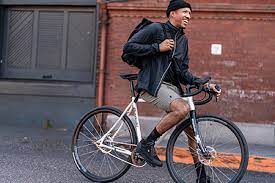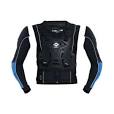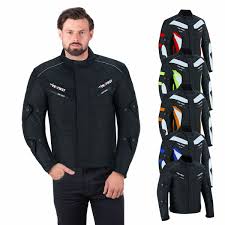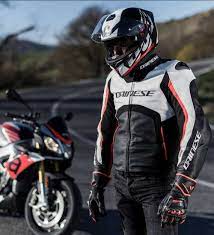
Bike Riding Gear: Your Ultimate Guide to Safety and Style
When it comes to bike riding, safety should always be a top priority. One essential aspect of ensuring your safety on the road is wearing the right gear. Not only does proper bike riding gear protect you from potential accidents, but it also adds a touch of style to your riding experience. In this article, we will explore the different types of gear that every rider should consider.
- Helmet: The most crucial piece of gear for any rider is a helmet. It safeguards your head in case of an accident and reduces the risk of severe head injuries. Look for a helmet that meets safety standards, fits snugly, and has proper ventilation for comfort during long rides.
- Jacket: A good-quality motorcycle jacket not only protects you from wind and weather but also provides essential protection in case of a fall. Look for jackets made from abrasion-resistant materials like leather or textile with built-in armor in critical areas such as elbows, shoulders, and back.
- Gloves: Your hands are vital while riding, so investing in a pair of sturdy gloves is essential. Look for gloves that offer good grip, protection against impact, and weather resistance. They should fit well without restricting movement.
- Boots: Proper footwear is crucial when it comes to bike riding gear. Opt for boots that cover your ankles and provide protection against impact and abrasion in case of an accident. Look for non-slip soles to ensure a firm grip on the footpegs.
- Pants: While regular jeans might seem comfortable, they offer little protection while riding. Consider investing in motorcycle-specific pants made from abrasion-resistant materials like leather or Kevlar-reinforced textiles with built-in armor at the knees and hips.
- Eye Protection: Protecting your eyes from debris, wind, and insects is essential for clear vision while riding. Choose between full-face helmets with built-in visors or invest in separate goggles or sunglasses that provide adequate protection.
- Reflective Gear: Enhancing your visibility on the road is crucial, especially during low-light conditions. Consider adding reflective elements to your riding gear, such as reflective strips on your jacket or helmet, to make yourself more visible to other motorists.
Remember, it’s not just about safety; bike riding gear can also be an expression of style and personality. With a wide variety of options available in the market, you can find gear that matches your taste while still prioritizing safety.
Before purchasing any gear, make sure to try it on and ensure a proper fit. Ill-fitting gear can compromise both comfort and safety. Additionally, always check for safety certifications and reviews before making a purchase.
In conclusion, wearing the right bike riding gear is essential for every rider. It not only protects you from potential accidents but also adds an element of style to your overall riding experience. Invest in high-quality gear that meets safety standards and fits well to ensure both safety and comfort on the road. Ride safe, ride stylish!
Essential Tips for Bike Riding Gear in the UK
- Wear a helmet
- Wear bright clothing
- Choose the right shoes
- Invest in lights
- Check brakes regularly
- Carry tools with you
Wear a helmet
Wear a Helmet: Your Lifesaver on Two Wheels
When it comes to bike riding gear, there is one item that stands above the rest in terms of importance: the helmet. Wearing a helmet is not just a suggestion; it’s a necessity that can save your life.
A helmet serves as your first line of defense against head injuries in case of an accident. It absorbs the impact and protects your skull and brain from severe trauma. The statistics speak for themselves – wearing a helmet significantly reduces the risk of fatal head injuries while riding.
When choosing a helmet, there are a few key factors to consider. Firstly, ensure that it meets safety standards such as those set by regulatory bodies like DOT (Department of Transportation) or ECE (Economic Commission for Europe). Look for certification stickers or labels inside the helmet to verify its compliance.
Fit is another crucial aspect when selecting a helmet. A properly fitting helmet should sit snugly on your head without any pressure points or excessive movement. It should cover your forehead and sit level, with the chin strap securely fastened under your chin.
Ventilation is also essential, especially during hot weather or long rides. Look for helmets with adequate vents that allow airflow while still providing protection.
Remember, helmets are not just for high-speed rides or off-road adventures; they are necessary regardless of your riding style or experience level. Accidents can happen at any time, even during short trips around town.
Some riders may argue that helmets are uncomfortable or mess up their hair, but these concerns pale in comparison to the potential consequences of not wearing one. Prioritize safety over temporary discomfort or vanity – your life and well-being are worth it.
Wearing a helmet should be an ingrained habit every time you hop on your bike. Make it part of your routine along with other essential gear like gloves, jackets, and proper footwear.
In conclusion, wearing a helmet while riding is non-negotiable. It protects your most valuable asset – your head – and significantly reduces the risk of severe injuries. Choose a helmet that meets safety standards, fits well, and provides adequate ventilation. Don’t compromise on safety – wear a helmet every time you ride and set an example for others to follow. Your life is worth protecting!
Wear bright clothing
Enhance Your Visibility: The Importance of Wearing Bright Clothing While Riding
When it comes to bike riding gear, safety should always be a top priority. One simple yet effective tip to maximize your visibility on the road is to wear bright clothing. By opting for vibrant and eye-catching colors, you significantly increase your chances of being seen by other motorists, reducing the risk of accidents.
In a world filled with distractions, it’s essential to make yourself as visible as possible while riding. Bright clothing stands out against the backdrop of the road, making it easier for drivers to spot you from a distance. This becomes particularly important in low-light conditions or during adverse weather when visibility is already compromised.
By choosing bright colors such as fluorescent yellows, oranges, or greens, you create a visual contrast that draws attention. These colors are known for their high visibility and are often used in safety gear worn by professionals working in hazardous environments.
Additionally, consider incorporating reflective elements into your attire. Reflective strips or patches on your clothing can catch the headlights of other vehicles and further enhance your visibility at night or in dimly lit areas. This additional layer of safety ensures that you remain noticeable even when direct eye contact with drivers may not be possible.
Remember that being visible is not just about protecting yourself; it also promotes responsible riding behavior. When motorists can easily see you on the road, they are more likely to anticipate your movements and give you the space and respect you deserve as a cyclist.
While wearing bright clothing significantly improves your visibility, it should not replace other essential safety gear like helmets and reflective accessories. It is crucial to combine multiple safety measures for maximum protection while riding.
So next time you gear up for a ride, remember to incorporate bright-colored clothing into your ensemble. By doing so, you contribute to creating a safer environment for yourself and others on the road. Stay visible, stay safe!
Choose the right shoes
Choose the Right Shoes: Enhancing Safety and Comfort on Your Bike Rides
When it comes to bike riding gear, one often overlooked yet crucial aspect is choosing the right shoes. The shoes you wear while riding can significantly impact your safety and comfort on the road. Here are a few reasons why selecting appropriate footwear is essential for every rider.
- Enhanced Protection: Proper riding shoes provide protection to your feet and ankles in case of an accident or fall. Look for boots or shoes specifically designed for motorcycling, as they are made from durable materials that offer impact resistance and abrasion protection. These features can help prevent injuries during unfortunate incidents.
- Improved Grip: Maintaining a firm grip on the footpegs is essential while riding, especially during turns or sudden maneuvers. Riding shoes with non-slip soles provide excellent traction, allowing you to confidently control your bike without worrying about your feet slipping off the pegs.
- Weather Resistance: Riding in different weather conditions is inevitable, so having footwear that can withstand rain, wind, or heat is crucial for your comfort and safety. Look for shoes that offer weather-resistant features such as waterproofing or breathability, depending on the climate you usually ride in.
- Comfortable Fit: Long rides can take a toll on your feet if you’re not wearing comfortable shoes. Look for footwear with proper cushioning and support to reduce fatigue and discomfort during extended periods of riding. Additionally, ensure that the shoes fit well without being too tight or loose, as ill-fitting footwear can cause distractions while riding.
- Style and Versatility: Choosing the right shoes doesn’t mean compromising on style. There are numerous options available in terms of design and aesthetics that cater to different tastes and preferences. You can find riding shoes that not only provide safety but also complement your overall style.
Remember, when selecting riding shoes, it’s essential to prioritize functionality over fashion alone. While it’s great to find footwear that matches your personal style, ensure that it meets safety standards and offers the necessary protection for your feet.
Investing in high-quality riding shoes is a wise decision that can significantly enhance your overall riding experience. So, before you hop on your bike for your next adventure, make sure you have the right shoes on. Ride safely, comfortably, and confidently with the perfect pair of riding shoes!
Invest in lights
Invest in Lights: Enhancing Safety and Visibility on Your Bike
When it comes to bike riding gear, one often overlooked but incredibly important aspect is investing in lights. Whether you ride during the day or venture out at night, having proper lighting on your bike can significantly enhance your safety and visibility on the road.
First and foremost, lights are crucial for making yourself visible to other motorists. By having a front light and a rear light, you ensure that drivers can see you from a distance, reducing the risk of accidents. Even during daylight hours, lights can make a significant difference in catching the attention of drivers who might otherwise overlook your presence.
Furthermore, lights play a vital role in illuminating your path ahead. Riding in low-light conditions or at night can be challenging without proper lighting. A front light with sufficient brightness allows you to see any potential obstacles or hazards on the road, providing you with valuable reaction time.
When choosing lights for your bike, consider opting for LED lights as they are energy-efficient and provide excellent visibility. Look for lights that have multiple modes such as steady beam, flashing, or pulsating options. This versatility allows you to adjust the lighting according to different riding conditions and conserve battery life when needed.
Additionally, consider investing in additional safety features such as reflectors or reflective strips that can be attached to your bike or clothing. These reflective elements work in conjunction with your lights to enhance visibility from various angles, especially when approached by vehicles from the side.
Remember to always check local regulations regarding bike lighting requirements as they may vary depending on where you ride. Some areas may have specific laws regarding brightness levels and positioning of lights on your bike.
Investing in lights for your bike is a small yet significant step towards ensuring your safety while riding. Not only do they make you more visible to others on the road but also provide essential illumination for navigating through various riding conditions. Prioritize safety by incorporating high-quality lights into your bike riding gear. Ride confidently, knowing that you are doing everything possible to enhance your visibility and stay safe on the road.
Check brakes regularly
Check Brakes Regularly: Ensuring Your Safety on Two Wheels
When it comes to bike riding, safety should always be a top priority. One crucial aspect of staying safe on the road is maintaining your bike’s brakes. Regularly checking and maintaining your brakes not only helps prevent accidents but also ensures a smooth and enjoyable riding experience.
Your bike’s brakes are its lifeline, allowing you to slow down or come to a complete stop when needed. Here are a few reasons why checking your brakes regularly is essential:
Safety: Properly functioning brakes are crucial for your safety and the safety of others on the road. Regular checks help identify any potential issues, such as worn brake pads or damaged cables, that could compromise your ability to stop effectively.
Performance: Well-maintained brakes provide optimum performance, giving you better control over your bike. Checking them regularly ensures that they are in good working condition, allowing you to respond quickly in any situation.
Longevity: Regular maintenance extends the lifespan of your brakes. By catching issues early on, you can address them promptly, preventing further damage and potentially costly repairs down the line.
So how can you check your bike’s brakes?
Visual Inspection: Start by visually inspecting the brake pads for wear and tear. Look for any signs of thinning or unevenness in their surface.
Brake Lever Resistance: Squeeze the brake levers and check for resistance. They should feel firm and not too loose or spongy.
Brake Pad Alignment: Ensure that the brake pads align properly with the braking surface (rim or disc). Misaligned pads can reduce braking efficiency.
Brake Cable Tension: Check that the brake cables are properly tensioned and not frayed or damaged.
Brake Fluid (if applicable): If you have hydraulic disc brakes, check the brake fluid level and ensure it is within the recommended range.
If you notice any issues during your brake check, it’s crucial to address them promptly. Replace worn brake pads, adjust cable tension, or seek professional help if needed. Regular maintenance and occasional professional servicing will help keep your brakes in top condition.
Remember, a well-maintained bike with properly functioning brakes is key to a safe and enjoyable riding experience. By checking your brakes regularly, you can ride with confidence, knowing that you have the control and stopping power when you need it most. Stay safe on two wheels!
Carry Tools with You: A Must-Have Tip for Every Bike Rider
When it comes to bike riding, being prepared for unexpected situations is key. One invaluable tip that every rider should follow is to carry essential tools with them on their journeys. Whether you’re a seasoned rider or a beginner, having the right tools can save you from potential headaches and keep your ride smooth and enjoyable.
Carrying tools with you while riding ensures that you can handle minor repairs or adjustments on the go. Here are a few essential tools that every rider should consider having in their kit:
- Multi-Tool: A compact multi-tool is a must-have for any rider. It typically includes various sizes of Allen keys, screwdrivers, and even a chain tool. With a multi-tool, you can tighten loose bolts, adjust your bike’s components, and fix minor mechanical issues.
- Tire Repair Kit: Flat tires are an unfortunate reality of biking. Having a tire repair kit handy can save you from being stranded on the side of the road. These kits usually include patches, glue, tire levers, and a pump or CO2 inflator to get you back on your way quickly.
- Spare Inner Tube: Carrying a spare inner tube is highly recommended in case of irreparable damage to your tire or valve failure. Make sure it’s the correct size for your bike’s tires and learn how to replace an inner tube before heading out on your rides.
- Chain Lubricant: Keeping your bike’s chain well-lubricated is crucial for smooth shifting and efficient pedaling. Carry a small bottle of chain lubricant in your kit to apply when needed, especially during long rides or in wet conditions.
- Zip Ties and Duct Tape: These versatile items can come in handy for temporary fixes or securing loose parts until you reach a proper repair shop.
Remember, carrying tools doesn’t mean you have to be a professional mechanic. It’s about being self-sufficient and able to handle minor issues that may arise during your rides. However, if you’re unsure about making repairs or adjustments, it’s always wise to seek professional help.
Before each ride, take a moment to check that your tools are in good condition and easily accessible. Consider investing in a small saddlebag or frame bag to keep your tools organized and secure while riding.
Carrying tools with you is not only practical but also empowers you to be self-reliant on the road. So, whether you’re embarking on a short commute or an adventurous long-distance ride, make sure to pack your essential tools and enjoy the freedom of knowing you’re prepared for whatever comes your way. Safe travels!





